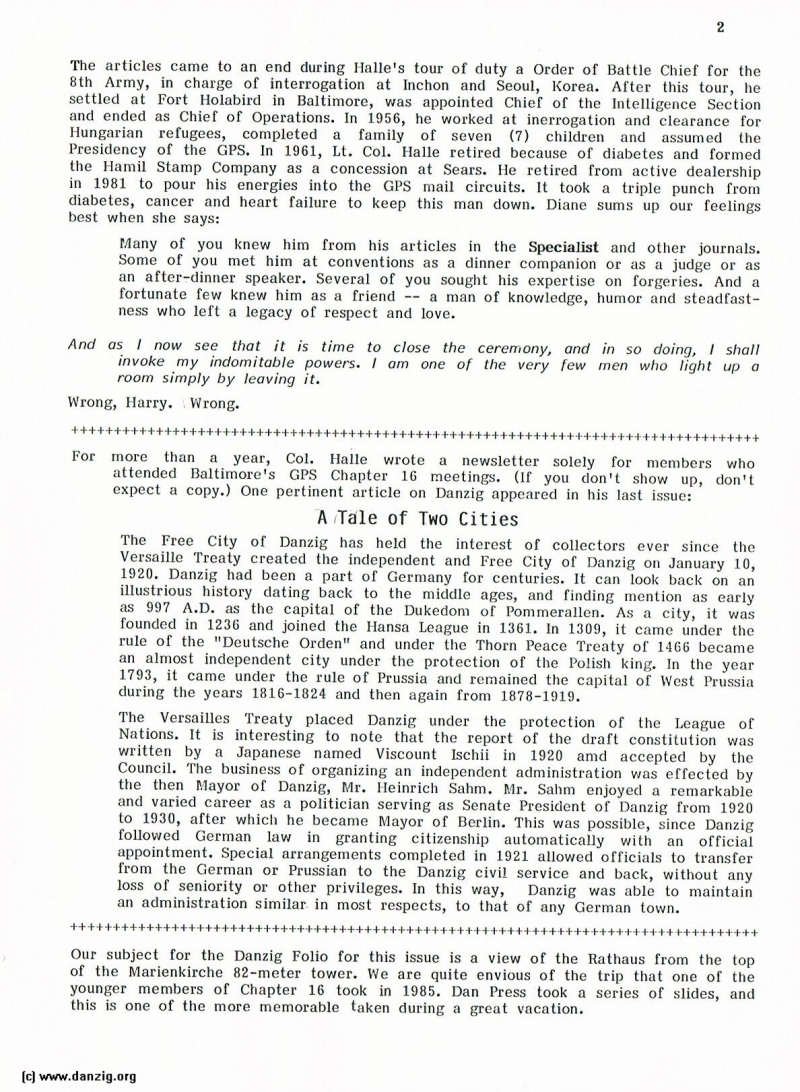
The articles came to an end during Ilalle’s tour of duty a Order of Battle Chief for the 8th Army, in charge of interrogation at Inchon and Seoul, Korea. After this tour, he settled at Fort 1-lolabird in Baltimore, was appointed Chief of the Intelligence Section and ended as Chief of Operations. In 1956, he worked at inerrogation and clearance for Hungarian refugees, completed a family of seven (7) chilclreti and assumed the Presidency of the GPS. In 1961, Lt. Col. Halle retired because of diabetes arid formed the Hamil Stamp Company as a concession at Sears. lie retired from active dealership in 1981 to pour his energies into the GPS mail circuits. It took a triple punch from diabetes, cancer and heart failure to keep this man down. Diane sums up our feelings best when she says:
Many of you knew him from his articles in the Specialist and other journals. Some of you met him at conventions as a dinner companion or as a judge or as an after—dinner speaker. Several of you sought his expertise on forgeries. And a fortunate few knew him as a friend —— a man of knowledge, humor and steadfastn ess who left a legacy of respect and love.
And as I nowsee that it is time to close the ceremony, and in so doing, I shall invoke my indomitable powers. I am one of the very few men who light up a room simply by leaving it.
Wrong, Harry. Wrong.
For more than a year, Col. Ilalle wrote a newsletter solely for members who attended Baltimore’s GPS Chapter 16 meetings. (If you don’t show up, don’t expect a copy.) One pertinent article on Danzig appeared in his last issue:
A Tale of Two Cities
The Free City of Danzig has held the interest of collectors ever since the Versaille Treaty created the independent and Free City of Danzig on January 10, 1920. Danzig had been a part of Germany for centuries. It can look back on an illustrious history dating back to the middle ages, and finding mention as early as 997 A.D. as the capital of the Dukedom of Pommerallen. As a city, it was founded in 1236 and joined the Hansa League in 1361. In 1309, it came under the rule of the “Deutsche Orden” and tinder the Thorn Peace Treaty of 1466 became an almost independent city under the protection of the Polish king. In the year 1793, it came under the rule of Prussia and remained the capital of West Prussia during the years 1816—1824 and then again from 1878—1919.
The Versailles Treaty placed Danzig under the protection of the League of Nations, It is interesting to note that the report of the draft constitution was written by a Japanese named Viscount Ischii in 1920 arnd accepted by the Council. The business of organizing an independent administration was effected by the then Mayor of Danzig, Mr. Heinrich Sahm. Mr. Sahm enjoyed a remarkable and varied career as a politician serving as Senate President of Danzig from 1920 to 1930, after which he became Mayor of Berlin. This was possible, since Danzig followed German law in granting citizenship automatically with an official appointment. Special arrangements completed in 1921 allowed officials to transfer from the German or Prussian to the Danzig civil service and back, without any loss of seniority or other privileges. In this way, Danzig was able to maintain an administration similar, in most respects, to that of any German town.
Our subject for the Danzig Folio for this issue is a view of the Rathaus from the top of the Marienkirche 82-meter tower. We are quite envious of the trip that one of the younger members of Chapter 16 took in 1985. Dan Press took a series of slides, and this is one of the more memorable taken during a great vacation.
Danzig Report Vol. 1 - Nr. 54 - January - February - March - 1987, Page 2.
Hits: 3375
Added: 21/06/2015
Copyright: 2025 Danzig.org

